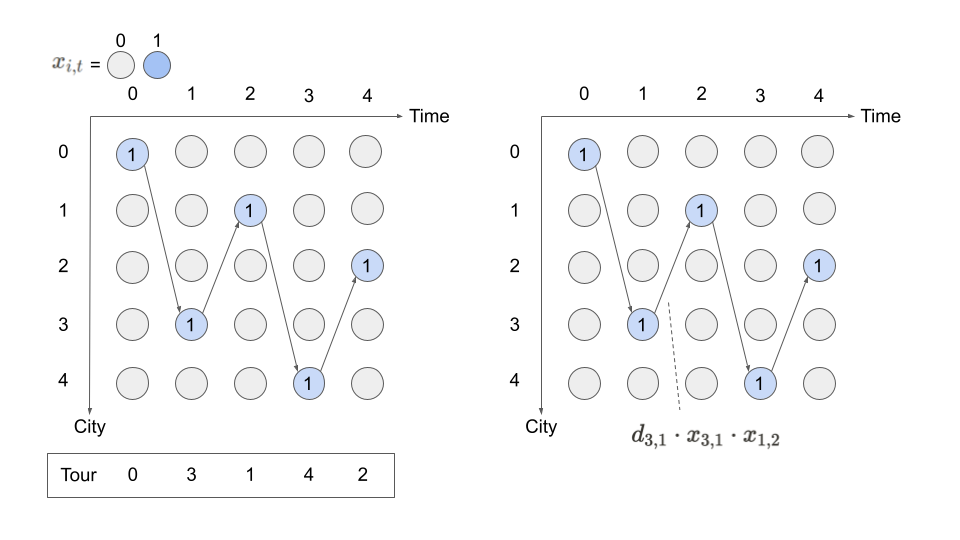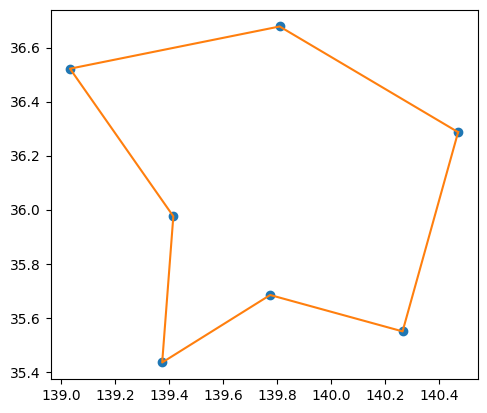Traveling Salesman Problem
The Travelling Salesman Problem (TSP) is the problem of finding the shortest tour salesman to visit every city. It is known as an NP-hard problem. There are several well-known linear formulations for TSP. However, here we show a quadratic formulation for TSP because it is more suitable for Annealing.
Mathematical model
Let's consider -city TSP.
Decision variable
A binary variables are defined as:
for all and . represents the salesman visits city at when it is 1.
Constraints
We have to consider two constraints;
A city is visited only once.
The salesman visits only one city at a time.
The following figure illustrates why these two constraints are needed for to represent a tour.

Objective function
The total distance of the tour, which is an objective function to be minimized, can be written as follows using the product of representing the edges used between and .
where is a distance between city and city . "" is used to include in the sum the distance from the last city visited back to the first city visited. For example, when is equal to 5 and node is the first city visited, means .
-city TSP.
where is distance between city and city .
Modeling by JijModeling
Next, we show an implementation using JijModeling. We first define variables for the mathematical model described above.
import jijmodeling as jm
# define variables
d = jm.Placeholder('d', ndim=2)
N = d.len_at(0, latex="N")
i = jm.Element('i', belong_to=(0, N))
j = jm.Element('j', belong_to=(0, N))
t = jm.Element('t', belong_to=(0, N))
x = jm.BinaryVar('x', shape=(N, N))
d is a two-dimensional array representing the distance between each city.
N denotes the number of cities. This can be obtained from the number of rows in d.
i, j and t are subscripts used in the mathematical model described above.
Finally, we define the binary variable x to be used in this optimization problem.
# set problem
problem = jm.Problem('TSP')
problem += jm.sum([i, j], d[i, j] * jm.sum(t, x[i, t]*x[j, (t+1) % N]))
problem += jm.Constraint("one-city", x[:, t].sum() == 1, forall=t)
problem += jm.Constraint("one-time", x[i, :].sum() == 1, forall=i)
jm.sum([i, j], d[i, j] * jm.sum(t, x[i, t]*x[j, (t+1) % N])) represents objective function .
The following jm.Constraint("one-city", x[:, t] == 1, forall=t) represents a constraint to visit one city at one time.
x[:, t] allows us to express concisely.
We can check the implementation of the mathematical model on the Jupyter Notebook.
problem
Prepare an instance
We prepare the number of cities and their coordinates.
Here we select a metropolitan area in Japan using geocoder.
from geopy.geocoders import Nominatim
import numpy as np
geolocator = Nominatim(user_agent="python")
# set the name list of traveling points
points = ['茨城県', '栃木県', '群馬県', '埼玉県', '千葉県', '東京都', '神奈川県']
# get the latitude and longitude
latlng_list = []
for point in points:
location = geolocator.geocode(point)
if location is not None:
latlng_list.append([ location.latitude, location.longitude ])
# make distance matrix
num_points = len(points)
inst_d = np.zeros((num_points, num_points))
for i in range(num_points):
for j in range(num_points):
a = np.array(latlng_list[i])
b = np.array(latlng_list[j])
inst_d[i][j] = np.linalg.norm(a-b)
# normalize distance matrix
inst_d = (inst_d-inst_d.min()) / (inst_d.max()-inst_d.min())
geo_data = {'points': points, 'latlng_list': latlng_list}
instance_data = {'d': inst_d}
Solve by JijZept's SA
We solve this problem using JijZept JijSASampler. We also use the parameter search function by setting search=True.
import jijzept as jz
# set sampler
sampler = jz.JijSASampler(config="config.toml")
# solve problem
multipliers = {"one-city": 0.5, "one-time": 0.5}
response = sampler.sample_model(problem, instance_data, multipliers, num_reads=100, search=True)
Check the results
results.record: store the value of solutionsresults.evaluation: store the results of the evaluation of the solutions.
First, check the results of the evaluation.
# get sampleset
sampleset = response.get_sampleset()
# get the values of objective function
# The number of samples is the same as num_reads multiplied by num_search (If search=True)
objectives = [sample.eval.objective for sample in sampleset]
# get the values of constraint vlolation
one_city_violations = [sample.eval.constraints["one-city"].total_violation for sample in sampleset]
one_time_violations = [sample.eval.constraints["one-time"].total_violation for sample in sampleset]
# set the number of showing result
# resutls are not sorted, so the lower objective value does not always come first
max_show_num = 5
# show the results
print("Objective: ", objectives[:max_show_num])
print("One-city violation: ", one_city_violations[:max_show_num])
print("One-time violation: ", one_time_violations[:max_show_num])
Objective: [1.9436576668549268, 1.045598017309573, 1.045598017309573, 1.8834731017537, 1.9436576668549268]
One-city violation: [1.0, 2.0, 3.0, 1.0, 1.0]
One-time violation: [1.0, 2.0, 1.0, 1.0, 1.0]
Extract feasible solutions and an index of the lowest solution
From the results, we extract the feasible solutions and show the lowest value of the objective function among them.
Note: There is a possibility that the solutions which violates constraints are included in the results.
import numpy as np
# extract feasible solutions
feasible_samples = sampleset.feasibles()
# get the value of feasible objective function
feasible_objectives = [sample.eval.objective for sample in feasible_samples]
# get the lowest value of objective function
lowest_index = np.argmin(feasible_objectives)
# show the result
print(f"Lowest solution index: {lowest_index}, Lowest objective value: {feasible_objectives[lowest_index]}")
Lowest solution index: 4, Lowest objective value: 2.8774493667284857
Draw tour
# get the indices of x == 1
x_indices = feasible_samples[lowest_index].var_values["x"].values.keys()
# sort by time step
tour = [index for index, _ in sorted(x_indices, key=lambda x: x[1])]
tour.append(tour[0])
tour
[6, 5, 4, 0, 1, 2, 3, 6]
We check the salesman’s route.
import matplotlib.pyplot as plt
position = np.array(geo_data['latlng_list']).T[[1, 0]]
print(position)
plt.axes().set_aspect('equal')
plt.plot(*position, "o")
plt.plot(position[0][tour], position[1][tour], "-")
plt.show()
print(np.array(geo_data['points'])[tour])
[[140.4703384 139.8096549 139.033483 139.4160114 140.2647303 139.762221
139.374753 ]
[ 36.2869536 36.6782167 36.52198 35.9754168 35.549399 35.6821936
35.4342935]]

['神奈川県' '東京都' '千葉県' '茨城県' '栃木県' '群馬県' '埼玉県' '神奈川県']